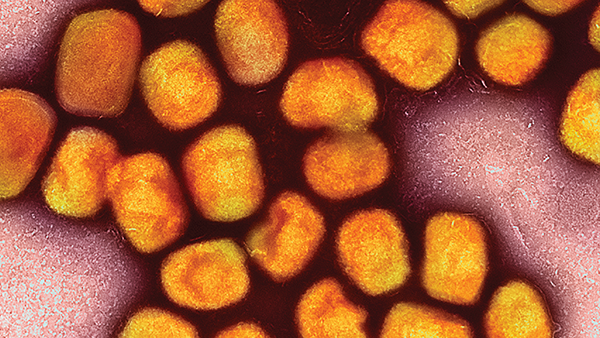Cloudy with a Chance of AMR
Research shows antibiotic resistance genes lurk high in the sky and can travel long distances
Antibiotic resistance is a natural occurrence, but widespread use of antibiotics to treat diseases in humans, animals, and plants has accelerated its development. These antibiotics can end up in the environment, such as rivers, seawater, soil, and wastewater, which can lead to bacteria in these environments developing resistance. Researchers from Laval University, Quebec, Canada, and the University of Clermont Auvergne, France, have sampled clouds at the puy de Dôme summit to investigate the presence of antibiotic resistance genes (ARGs) in clouds and their ability to be distributed over long distances in the atmosphere (1). We spoke with Florent Rossi, lead researcher on the study, to find out more…
What inspired you to investigate the presence of ARGs in clouds as a potential route for the spread of antibiotic resistance?
The idea came from Caroline Duchaine at Laval University, Canada, who gained funding for a project targeting ARG emissions from different human facilities across Canada and quantifying these resulting fluxes at a large scale. One component of the project was devoted to long-distance dispersion of these ARGs, so she collaborated with my previous post-doc supervisors, Anne-Marie Delort and Pierre Amato from the University of Clermont-Ferrand, France – pioneers in cloud microbiology for more than two decades.
Clouds are supposedly more favorable for microbial life than raw aerosols. The presence of water as micro-droplets provide protection against many stressors commonly encountered by bacteria during atmospheric transport (UV, desiccation) – allowing them to remain potentially active or viable for extended periods of time, thereby possibly favoring long-distance transport of ARGs.
How do clouds acquire ARGs in the first place?
Most of the observed ARGs are actually carried by bacteria. These bacteria can be aerosolized in the atmosphere by a variety of means, such as wind, but human activity also contributes to these emissions. Once in the air, some of the bacteria can eventually reach high altitudes ( >1000m above sea level) where they act as cloud condensation nuclei – condensing water around them and leading to the formation of clouds. Notably, all particles of a certain size can condense water, not just bacteria, and cloud formation also depends on meteorological factors, such as relative humidity, temperature, and concentration of the particles.
How did you collect ARG samples from clouds?
Clouds are a poor environment for bacteria cell concentrations, so it is necessary to collect for extended periods of time with an adapted collector to get the required quantities of biological material (in our case, DNA) and obtain a quantifiable signal. To mitigate this challenge, we used aspirator-like samplers – called high-flow-rate impingers – sampling at a flow rate of 2m3/min.
Because such a high flow rate is not without its consequences for bacteria, the tanks were filled with a solution to preserve the DNA for subsequent analyses.
The puy de Dôme meteorological observatory is 1465 meters above sea level. Unfortunately, cloud altitude varies from one event to another and is affected by outside temperature – clouds are higher during summer, lower during winter – so not all cloud events can be sampled. Thanks to our collaboration with the Earth Physics Observatory of Clermont-Ferrand and the Meteorology-Physics laboratory, we were given access to predictive models regarding the clouds’ altitude and events’ duration so we were able to efficiently collect the samples.
They use two different types of models: A predictive model – more like a weather forecast that we receive every morning – that predicts if there will soon be clouds at the puy de Dôme summit. It also provides their altitude, wind strength, and probabilities of precipitation so we can plan whether to sample or not within the next six to seven days. Figure 1 shows an example I received this morning. The blue shades represent clouds, the black line in the middle represents the puy de Dôme summit where sampling occurs. Whenever there is a blue shade that intercepts the black line, it means there will be clouds that day at the right altitude.

There is also a backward trajectory model that provides the air mass’ geographical origins and altitudes during the past three days before sampling so we can characterize the clouds (for example, “Oceanic,” if they spent more time above the ocean before reaching the observatory, or “continental,” if they spent more time above the continent).
What did you find?
We quantified the presence of ARGs in clouds at concentrations comparable to other surface ecosystems. Our results highlight that the cloud resistome can be viewed as a mosaic composed of antibiotic resistance from both distant origins and local landscapes – and that natural sources are important contributors of these genes. We also found a majority contribution from the Atlantic Ocean, partly constrained by the fact that the puy de Dôme observatory mainly receives air masses originating from the East. Overall, our results demonstrate that clouds are a tremendous potential reservoir of ARGs within the environment, and highlight the high atmosphere as a route for the large-scale dissemination of ARGs.
What are the potential implications for the global spread of antibiotic resistance?
Our results reveal that ARGs can transit across long distances in the free troposphere and that clouds may be important vehicles of these genes. However, the fate of these genes after deposition by precipitation remains unknown. Evidence in the literature shows that rain, for example, can bring many ARGs into receiving ecosystems, but this effect is only transient. To what extent these can be acquired by bacteria and confer antibiotic resistance is yet to be determined.
Reference
- F Rossi et al., “Quantification of antibiotic resistance genes (ARGs) in clouds at a mountain site (puy de Dôme, central France),” 865, 161264, Sci Total Environ (2023). PMID: 36587700.





